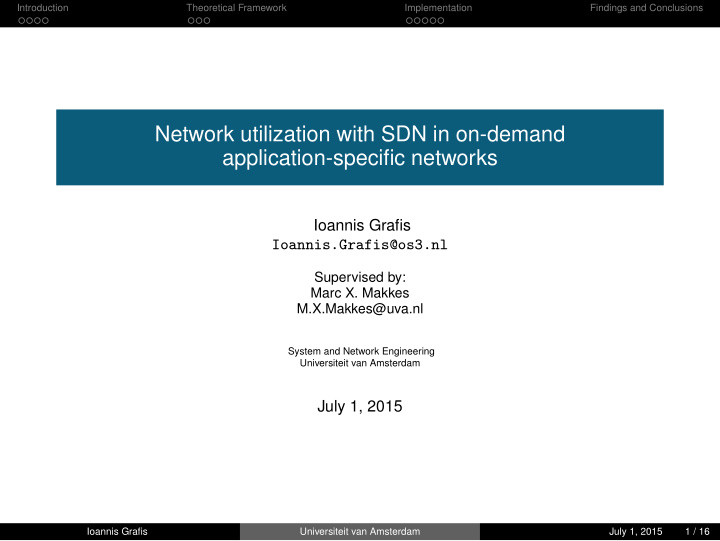



Introduction Theoretical Framework Implementation Findings and Conclusions Network utilization with SDN in on-demand application-specific networks Ioannis Grafis Ioannis.Grafis@os3.nl Supervised by: Marc X. Makkes M.X.Makkes@uva.nl System and Network Engineering Universiteit van Amsterdam July 1, 2015 Ioannis Grafis Universiteit van Amsterdam July 1, 2015 1 / 16
Introduction Theoretical Framework Implementation Findings and Conclusions Internet factories Internet factories: Creating application-specific networks on-demand[1] Uses Infastructure-as-a-Service clouds Create, configure and modify the infastructure Second implementation Compute factory Ioannis Grafis Universiteit van Amsterdam July 1, 2015 2 / 16
Introduction Theoretical Framework Implementation Findings and Conclusions Overlay networks A network built on top of one or more existing networks Add extra functionality Ioannis Grafis Universiteit van Amsterdam July 1, 2015 3 / 16
Introduction Theoretical Framework Implementation Findings and Conclusions OSPF / SDN comparison Open Shortest Path First (OSPF) : Software Defined Networking (SDN): Mature protocol Separation between control plane and data plane Widely used and supported Centralized managment Uses Dijkstra’s algorithm Programmability Used by Compute factory Routing granularity Ioannis Grafis Universiteit van Amsterdam July 1, 2015 4 / 16
Introduction Theoretical Framework Implementation Findings and Conclusions Hypothesis If the created overlay networks make use of SDN (OpenFlow), Compute factory’s control loops that observe and modify the behavior can gain benefits. Ioannis Grafis Universiteit van Amsterdam July 1, 2015 5 / 16
Introduction Theoretical Framework Implementation Findings and Conclusions Related work B4: Experience with a Globally-Deployed Software Defined WAN[2] MiceTrap: Scalable Traffic Engineering of Datacenter Mice Flows using OpenFlow[3] SDN Based Load Balancing Mechanism for Elephant Flow in Data Center Networks[4] Ioannis Grafis Universiteit van Amsterdam July 1, 2015 6 / 16
Introduction Theoretical Framework Implementation Findings and Conclusions Differences from our case Virtual Machine migration Connection speed Dynamic infrastructure Ioannis Grafis Universiteit van Amsterdam July 1, 2015 7 / 16
Introduction Theoretical Framework Implementation Findings and Conclusions Elephants and Mice flows Elephant flow: Long-lived flow with large data transfer Mice flow: Short-lived flow with small data transfer Ioannis Grafis Universiteit van Amsterdam July 1, 2015 8 / 16
Introduction Theoretical Framework Implementation Findings and Conclusions Compute factory Ioannis Grafis Universiteit van Amsterdam July 1, 2015 9 / 16
Introduction Theoretical Framework Implementation Findings and Conclusions Compute factory flow control loop Ioannis Grafis Universiteit van Amsterdam July 1, 2015 10 / 16
Introduction Theoretical Framework Implementation Findings and Conclusions Scenarios First Transfer sequential small and large file in empty path Second Transfer simultaneously small and large file with the Copmute factory control loop disabled Third Transfer simultaneously small and large file with the Copmute factory control loop enabled Ioannis Grafis Universiteit van Amsterdam July 1, 2015 11 / 16
Introduction Theoretical Framework Implementation Findings and Conclusions Scenario results Total time transferring a file Ioannis Grafis Universiteit van Amsterdam July 1, 2015 12 / 16
Introduction Theoretical Framework Implementation Findings and Conclusions CPU utilization CPU utilization in the intermediate switches Ioannis Grafis Universiteit van Amsterdam July 1, 2015 13 / 16
Introduction Theoretical Framework Implementation Findings and Conclusions Conclusions Increase stability in data transfer Dicrease jitter Balance the CPU load in intermediate switches Not increase network utilization Ioannis Grafis Universiteit van Amsterdam July 1, 2015 14 / 16
Introduction Theoretical Framework Implementation Findings and Conclusions Thank you Ioannis Grafis Universiteit van Amsterdam July 1, 2015 15 / 16
Introduction Theoretical Framework Implementation Findings and Conclusions References I Rudolf Strijkers, Marc X. Makkes, Cees de Laat, Robert Meijer Internet factories: Creating application-specific networks on-demand Computer Networks , 68:187-198, 2014. Sushant Jain et al. B4: Experience with a Globally-Deployed Software Defined WAN ACM SIGCOMM , 3-14, 2013. Trestian R., Muntean G.-M., Katrinis K. MiceTrap: Scalable Traffic Engineering of Datacenter Mice Flows using OpenFlow Integrated Network Management , 904-907 , 2013. Jing Liu, Jie Li, Guochu Shou, Yihong Hu, Zhigang Guo, Wei Dai SDN Based Load Balancing Mechanism for Elephant Flow in Data Center Networks Wireless Personal Multimedia Communications , 486-490, 2014. Ioannis Grafis Universiteit van Amsterdam July 1, 2015 16 / 16
Recommend
More recommend